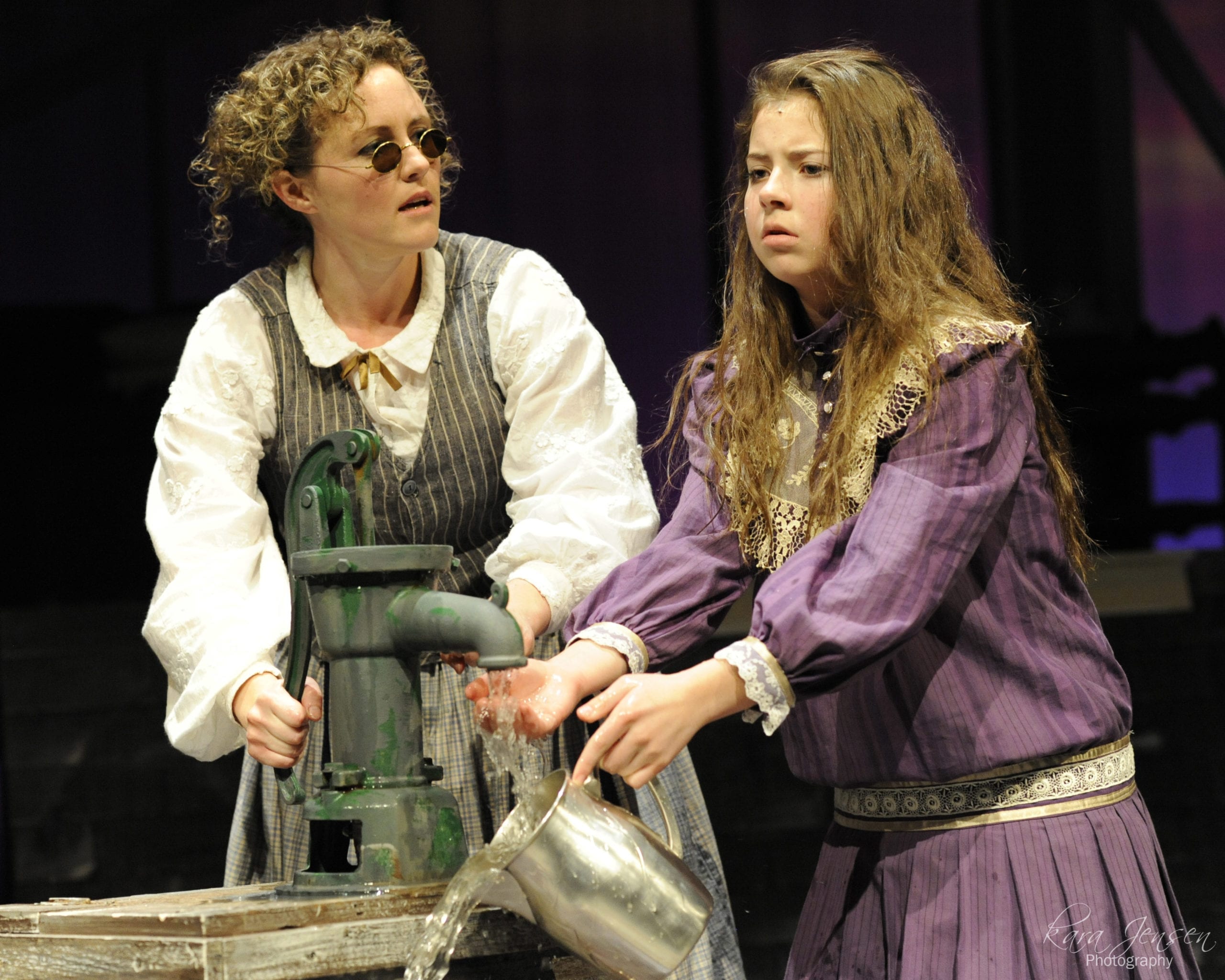CENTERVILLE — Centerpoint Legacy Theatre has stepped away from its typical musical theatre offerings to share a beautiful story of determination, hope, and ultimately the purest kind of love: The Miracle Worker by William Gibson. It is the story of Helen Keller, a young girl born with normal sight and hearing, but who loses both after a childhood bout with smallpox. As she grows, locked in a black, silent world, she and her genteel Southern family struggle along the best they can (which is to say, not very well). But then a brash, opinionated young Northern woman named Annie Sullivan crashes into their lives, bringing chaos and upheaval in her wake at first. Ultimately, Annie unlocks the door to Helen’s active and fertile mind. It is a touching story, and director Karen Whiting has done a lovely job in bringing this story and these characters to the stage.
First and foremost, I commend the two leading ladies. First, Jillian Joy as Annie Sullivan portrayed a no-nonsense, straight talking, nearly blind Irish girl who is hired by a desperate family to do whatever she can to help their daughter. Annie Sullivan is actually not very likeable when she first arrives, and clashes badly with the family, especially Captain Keller (played by Chuck Gilmore). The family appears to only go along with her brusque and borderline abusive treatment of Helen because the only other alternative is to place her in an asylum—a grim prospect. Joy created a character that was nuanced in the way she showed her love and caring towards the Kellers.
 Second, Emma Leishman as young Helen Keller pulled off an excellent performance as the deaf and blind young girl. Never did I once see a stray glance or reaction that would give away that this actress was not truly living in darkness and silence. In fact, it was almost jarring when she came out for her curtain call and could clearly see. Leishman and Joy worked well together to establish a relationship that was at first quite shockingly adversarial, but ultimately caring and trusting. The physicality in the early struggles would border on abuse by today’s standards, with slaps and punches and mean tricks at the beginning. Helen did not accept this stranger into her life quietly, and Annie was just as obstinate in getting her way with what she saw as, first and foremost, a spoiled child. I was a little uncomfortable at times, yet I could also see how the struggle between Annie and Helen was necessary and ultimately brought about the trust needed for them both to grow and change. Annie Sullivan worked a miracle on Helen Keller, but she was not untouched by her experience with Helen, either.
Second, Emma Leishman as young Helen Keller pulled off an excellent performance as the deaf and blind young girl. Never did I once see a stray glance or reaction that would give away that this actress was not truly living in darkness and silence. In fact, it was almost jarring when she came out for her curtain call and could clearly see. Leishman and Joy worked well together to establish a relationship that was at first quite shockingly adversarial, but ultimately caring and trusting. The physicality in the early struggles would border on abuse by today’s standards, with slaps and punches and mean tricks at the beginning. Helen did not accept this stranger into her life quietly, and Annie was just as obstinate in getting her way with what she saw as, first and foremost, a spoiled child. I was a little uncomfortable at times, yet I could also see how the struggle between Annie and Helen was necessary and ultimately brought about the trust needed for them both to grow and change. Annie Sullivan worked a miracle on Helen Keller, but she was not untouched by her experience with Helen, either.
 The rest of the cast was similarly excellent. The aforementioned Chuck Gilmore as Captain Keller was a good foil for Annie. The captain is clearly not used to a woman, especially such a young one, who speaks her mind and is used to fending for herself through life. He much prefers his milquetoast wife Kate (played by Krystal Day) who barely has the gumption to express a contrasting opinion, yet obviously loves her daughter. There is Helen’s surly, angry half-brother James (played by Andrew Heyward) who has his own issues of abandonment to work through. Heyward was able to create a nice arc to his character’s journey, wherein he journeys from being almost completely unlikeable at the beginning to becoming very sympathetic by the end of the play. James’s story adds layers and subtlety to the Keller family dynamic. Two other side actors, Natasha Asmus as the servant Viney and Tara Lane Berrett as Aunt Ev, round out the central cast, while an army of servants (mostly glorified stage hands in servants costumes) handled the minimal set changes.
The rest of the cast was similarly excellent. The aforementioned Chuck Gilmore as Captain Keller was a good foil for Annie. The captain is clearly not used to a woman, especially such a young one, who speaks her mind and is used to fending for herself through life. He much prefers his milquetoast wife Kate (played by Krystal Day) who barely has the gumption to express a contrasting opinion, yet obviously loves her daughter. There is Helen’s surly, angry half-brother James (played by Andrew Heyward) who has his own issues of abandonment to work through. Heyward was able to create a nice arc to his character’s journey, wherein he journeys from being almost completely unlikeable at the beginning to becoming very sympathetic by the end of the play. James’s story adds layers and subtlety to the Keller family dynamic. Two other side actors, Natasha Asmus as the servant Viney and Tara Lane Berrett as Aunt Ev, round out the central cast, while an army of servants (mostly glorified stage hands in servants costumes) handled the minimal set changes.
 The unit set, also designed by Karen Whiting, worked well for the most part. The open framed design was reminiscent of Thornton Wilder’s Our Town, and allowed all areas of the house and yard to be seen at all times. The dining room, the scene of Annie and Helen’s defining struggle, was appropriately dominant, which emphasized the pivotal nature of the scenes that took place there. The only weak point was perhaps the cramped space downstage right. It played double duty as the yard for the pump (which worked fine) and also the garden house (which was less effective). But, overall, when the curtain rose on the first act, the time and place were very clear, and attractive to look at.
The unit set, also designed by Karen Whiting, worked well for the most part. The open framed design was reminiscent of Thornton Wilder’s Our Town, and allowed all areas of the house and yard to be seen at all times. The dining room, the scene of Annie and Helen’s defining struggle, was appropriately dominant, which emphasized the pivotal nature of the scenes that took place there. The only weak point was perhaps the cramped space downstage right. It played double duty as the yard for the pump (which worked fine) and also the garden house (which was less effective). But, overall, when the curtain rose on the first act, the time and place were very clear, and attractive to look at.
The lighting design (designed by Mark Rencher) was subtle and not distracting, and the costume design (by Jennie Richardson and Wendy Nagao) provided information about the time period of the play, along with the economic and social status of the Kellers, Annie, and the servants. All the design elements worked seamlessly together to create the world of the story.
The Miracle Worker is a play that is not often produced here in musical-happy Northern Utah, and I would recommend it anyone looking for a short break from the song and dance. It is a lovely story, with strong characters and an uplifting message. This production is suitable for all ages, and I highly suggest readers attend it.






